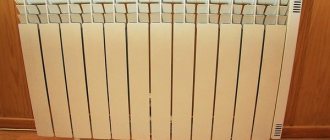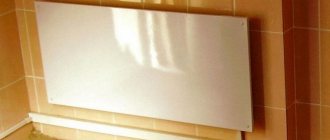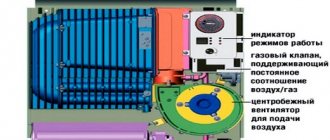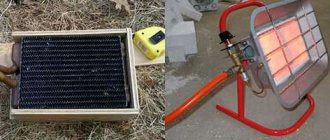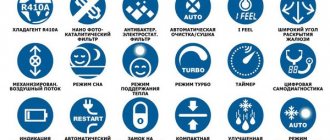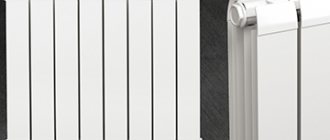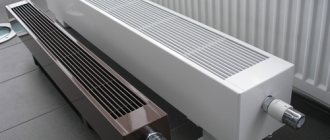Which heater is the most energy efficient?
Before the start of the heating season, it is worth considering in advance which equipment will be optimal for your home.
There are several types of heaters:
- Electric (convector).
- Infrared.
- Micathermic.
- Air conditioner.
- Ceramic plate (panel).
Electric heater in the interior
Electric convector
Its operating principle is similar to that of an oil cooler. Air circulates through the heating element. The heated air rises and, after cooling, falls to reheat.
The most popular are Atlantic models. The power of convectors varies from 0.5 to 2.5 kW. To heat a room of 20 sq. m. it will take 4-5 hours.
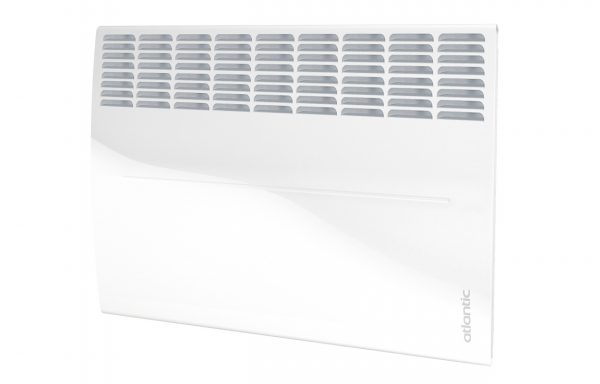
Electric convector Atlantic
Infrared heater
Oil and electrical products have been replaced by a new type of heating equipment. The energy consumption of such equipment is significantly less. A quartz emitter is a heating element that heats up and transfers heat to nearby objects. Such equipment does not heat the air. It is suitable for quickly heating a room. But it is not able to efficiently heat the entire house for a long time.
The infrared device can be installed outdoors. The equipment can be mounted to the ceiling or installed on legs. For heating a room up to 20 square meters. m. it will take 2 hours.
Popular models: Eko, Saturn, Beko, etc. The product consumes an average of 90 W per sq.m.
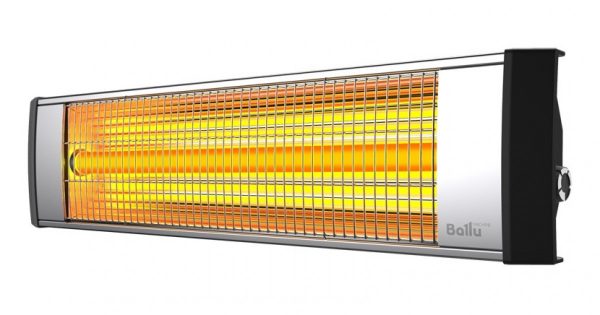
Micathermic heater
This product is distinguished by its economy and efficiency. It was developed using new technology and was released not so long ago. The equipment was previously used in astronautics and medical institutions. The equipment can be installed on the ceiling or wall.
A micathermic heater heats up efficiently because it has several plates that are coated with mica. It is safe as it does not get hot. Objects around the device heat up evenly.
There is one drawback in the equipment - high cost. A high-quality model is a product from Polaris with a power of 1.8 kW.
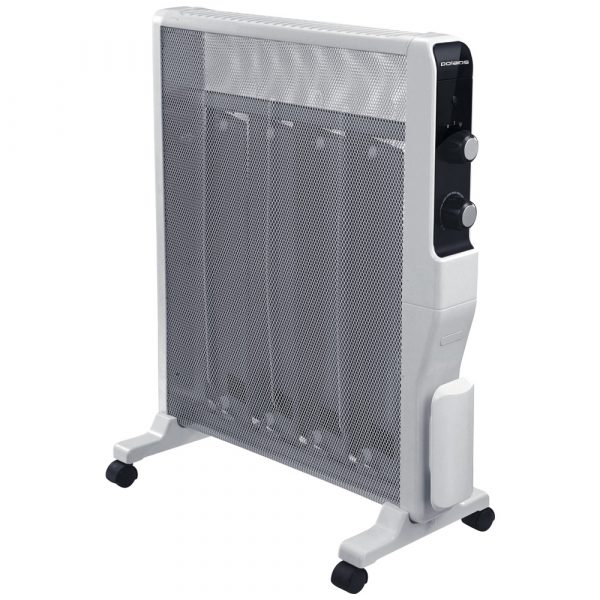
Micathermic heater Polaris
Air conditioner
The air conditioner is distinguished by its efficiency. Often used to heat a country house. The equipment consists of an indoor and outdoor unit. Heating a room is different from other heating devices.
The air conditioner is powered by a heat pump. It takes warm air inside the room using a heat exchanger. Therefore, even at negative temperatures, the air heats up and enters the house already warm. Freon is used for heating. Under the influence of pressure, the gas passes through the indoor unit in the heat exchanger and heats up to 80 degrees. After this, the freon goes to the outside and returns to the gas under low pressure. After boiling, it flows again into the indoor unit.
From 2 to 5 kW of electricity is consumed per hour, depending on the model. Air conditioners can heat houses even with a large area. Popular models: Samsung, Daikin and LG.
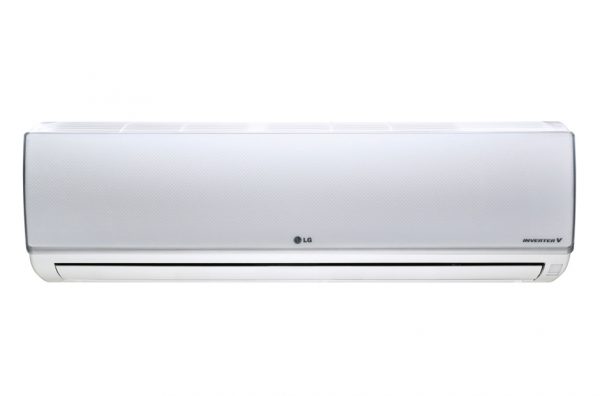
Ceramic panel
Such equipment is also considered economical. The device looks like a ceramic plate. It works on the principle of long-wave infrared radiation. Excellent for different interiors, as it has a steel heat-conducting box. The panel can be installed on a wall or ceiling.
To calculate electricity consumption, it is necessary to take into account the dimensions of the device. On average, the panel consumes 0.2-2.5 kW per hour. Room 20 sq. m. can fully heat up after 2 hours.
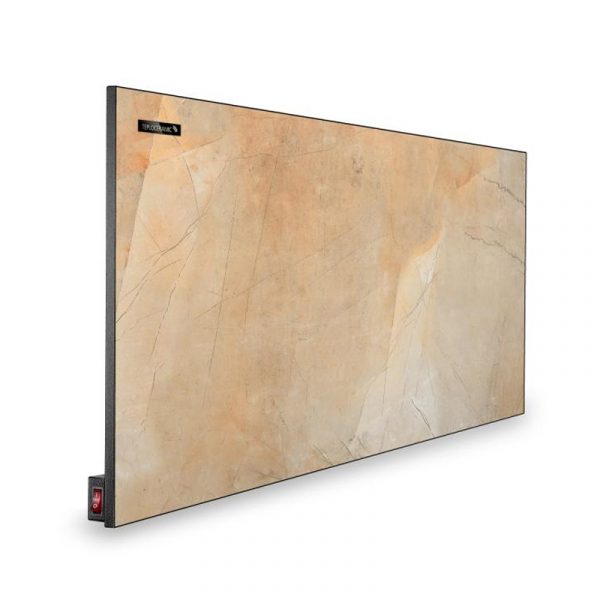
Advantages of heating with infrared devices
VERSATILITY. It can be installed both as main and auxiliary equipment in residential buildings, offices, and service premises.
PURE AND HARMLESS. The use of ceiling heaters does not cause convection drafts, dust sublimation, and reduces the risk of allergies. Due to the lack of high-temperature heating surfaces, the air in the room is not dehumidified.
ECONOMICAL. The system is economical to operate because the surfaces remain warm for a long time and, accordingly, a small amount of heat is required to maintain the desired temperature. A more uniform temperature distribution across the height of the room also contributes to efficiency. Fast heating compared to traditional heating systems
INCREASED COMFORT. It is known that a person’s well-being significantly improves with an increase in the temperature of the surfaces and objects surrounding him and a slight decrease in the temperature of the air around him. There is also a slight increase in relative humidity with a decrease in air temperature, which also contributes to the creation of comfortable indoor conditions.
RELIABILITY AND SAFETY. There are no hot surfaces that can be accidentally touched. The elements are made in a moisture-proof, fireproof design. The design of the elements and the use of modern automatic devices and RCDs eliminate the possibility of sparks and fires.
HEATING AND DRYING. Infrared heaters can be used in a variety of industrial processes for drying and heating.
QUICK INSTALLATION. The advantages also include simple installation, absence of visible elements and moving parts, and noiselessness.
Which heater consumes less electricity for a summer house and other homes?
Based on many experiments, we can single out one type that consumes less electricity. Such a device is a convector. The operating principle is similar to an oil radiator, but is distinguished by its safety and modernity.
Air circulates through the heating element, which is located in the convector. Thus, heat exchange occurs. The convector can be left on for a long time unattended, as it is one of the safest devices.
Such heating equipment is ideal for a country house. It does not dry the air, and the heating temperature cannot exceed 60 o C. After turning on the convector, the room will begin to heat up in 20 minutes. It consumes 25% less electricity than other heating devices.
The convector is considered the most economical for the home.
How much does an oil heater consume per day?
This type of heater burns a small amount of oxygen and consumes little electricity. In addition, they are not as fire hazardous as other devices.
The disadvantages are high cost and heavy weight. On average, an oil heater consumes 750W per hour. More powerful heaters consume about 1 kW. But you can find devices with less power.
Since the device operates several hours a day, electricity consumption is significantly less.
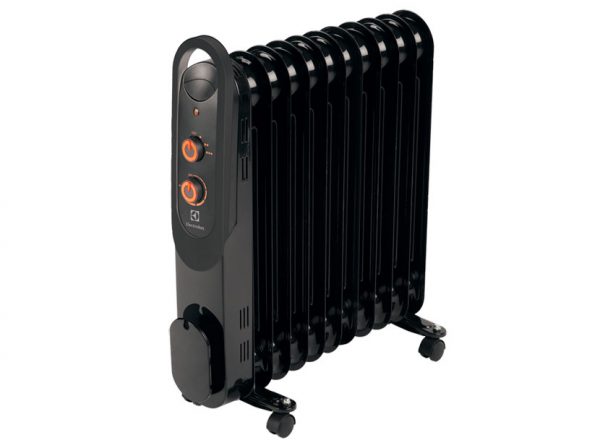
The higher the power of the device, the more electricity it consumes. When the device is turned off and in rest mode, it does not waste energy. Despite some disadvantages, there are more advantages. That is why it is popular among residents of private houses. You can calculate the amount of electricity consumed after 1 month of using the device.
What to consider when purchasing
When purchasing an oil heater, you need to pay attention to some important nuances:
- On its power: the larger the area of the heated room, the higher the power should be.
- For thickness, number of sections (the narrower they are, the faster they heat up and the less electricity is spent).
- The presence of a power regulator and an emergency shutdown thermostat that will turn off the device if it overheats.
- Of no small importance is the size of the heater, which depends on the number of sections (with a larger number, the power of the device will be higher, therefore, it will heat a larger area).
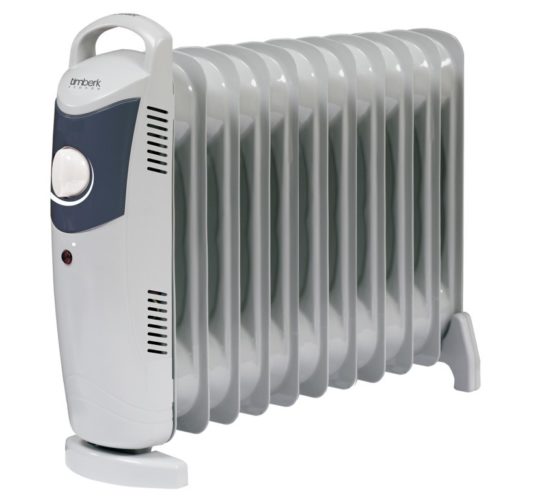
Knowing the following ratio will help you select an oil heater of the required power: a power of 1 kW helps to heat a room of 10 m2.
How much energy does an infrared heater consume?
On average, such a heater consumes 0.5 kW per hour. This indicator indicates a high efficiency compared to other heating devices. If it works for about 10 hours a day, then it will consume 150 kWh per month. This electricity consumption can be considered a good indicator.
When purchasing a heater, you need to pay attention to the electricity consumption and power of the device. When choosing an infrared heater, power calculations must be made taking into account the area of the room, so as not to overpay for unnecessary electricity consumption.
Often circumstances force the use of an electric heater as an additional heat source. In the off-season and cold months of the year, it helps create comfortable indoor conditions. But using the device entails additional costs. Before using the device, thrifty owners ask themselves about the heater’s consumption: how much electricity it consumes, how much additional heating will cost. Let's try to figure it out.
Advantages and disadvantages
An oil heater is often called energy-saving because, no matter how much electricity it consumes during heating, the heat remains in the room for a long time after the device is turned off from the network. When purchasing such heating devices for a house or apartment, you need to take into account both their disadvantages and advantages. But, despite the fact that the devices heat up slowly and are somewhat cumbersome, they are still in great demand.
When comparing oil energy-saving units with other types of heaters, one can note their advantages such as:
- Relatively low cost.
- Equipped with a built-in fan (not available on all models).
- Reliability of the design.
- Quiet operation.
- Lightweight and easy to use.
- Availability of an electronic shutdown system.
- Ability to store heat for a long time.
- Mobility of movement.
- Availability of special protective equipment for safe use.
Consumption
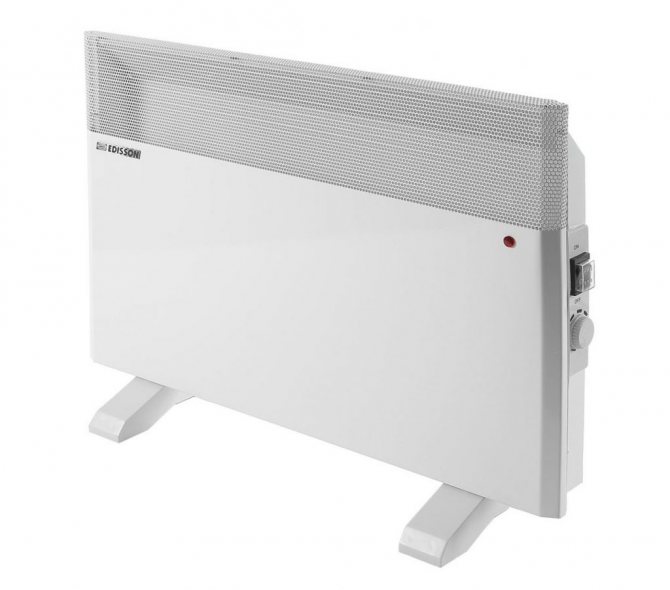
On the market you can find a lot of heaters of different modifications and sizes. Choosing the right model always makes you wonder: how much electricity does the heater consume, will the purchase be a big burden on the budget? To get a comprehensive answer, it is important to understand the variety of models and study their characteristics.
- Fan heater. The most cost-effective option for heating a room. A fan heater is a small structure with a spiral and a fan that disperses heat and creates circulation of air masses in the room. The air is heated in a matter of minutes, since the spiral is located open. The device negatively affects the air composition, so the use of this heater model should be periodic. Another disadvantage of the device is the high noise level during operation and severe drying of the air. It is worth noting that the device belongs to the category of fire hazard; leaving the fan heater unattended is strictly prohibited. The devices have high power, so it is unprofitable to use them for constant heating of premises. The advantages of the heater are low cost, compactness, and mobility.
- Oil heater. Heats the air intermittently, which allows you to consume less electricity during operation. The coolant is oil. As the oil warms up, heat penetrates the metal and spreads throughout the room. After turning off, the device cools down for another half hour, continuing to give off heat. The advantage of oil-type heaters is the absence of a negative impact on the composition of the air in the room; the problem of overdrying can be eliminated with the help of a humidifier. The device can be left turned on for a long period of time; oxygen is not burned. The device operates silently. The disadvantage is the slow heating of the room and the heavy weight of the device. Some models make monotonous sounds during operation, which can be unnerving.
- Floor or wall convectors. A very convenient type of climate control equipment. The device can be installed on a horizontal or vertical surface. The devices are capable of heating even very large areas. They belong to the category of devices that consume a small amount of electricity. The advantages of the heater include quiet operation and instant heating of the air in the room. Features a large size.
This is one of the safest types of devices.
A reliable device that does not have a negative impact on the composition of the air in the room. The heater quickly and efficiently warms the room.
- Quartz heater. This category includes two subtypes of devices: monolithic and infrared. The principle of operation of the device is to warm up objects in the room, which subsequently release the resulting heat. The combustion of oxygen by this type of heater is minimal. UV heaters are becoming increasingly popular. They belong to the category of economical, since spot heating allows you to save energy. Economical energy consumption makes it possible to use devices for a long period of time. They work silently. The disadvantages of the device are the high fragility of individual elements, high fire hazard, glow during operation, contraindications for use in certain diseases.
- Carbon heater. Used for zone heating. Does not have a negative effect on the composition of the air and does not dry it out. The advantages of the device include high efficiency: thanks to its design features, it does not take much time to warm up a large area. The tightness allows the device to be used in rooms with high humidity. Thanks to the closed housing, it can be safely used in children's rooms. The heater is equipped with a program for setting the temperature and has an automatic emergency shutdown. The disadvantages of the equipment include high cost, fragility of the main elements, and the presence of a slight glow during operation.
Carbon heaters: pros and cons, price and main characteristics
New types of heating include carbon heaters. The pros and cons, price and parameters of these products need to be studied before purchasing. These are compact designs with fast heating. In their design they have a vacuum quartz tube with carbon fiber. They warm up not the surrounding air, but objects. Such devices can even be installed outdoors.
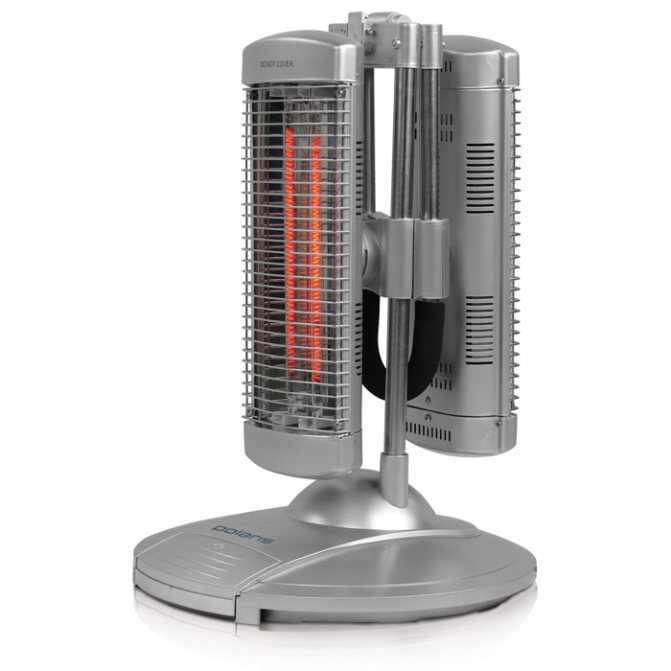
This device can be used as an addition to the main heating system.
Advantages of designs
To better understand what carbon heaters are, read reviews on the forums of users of this equipment. The main advantage of this design compared to fan heaters is their high performance and low energy consumption.

The unit can be used on verandas and attics
The advantages include:
- the presence of a powerful heat flow;
- the installation is protected from moisture penetration;
- in case of problems with the network or accidental overturning, the structure immediately turns off;
- possibility of directional heating;
- compact and silent operation.
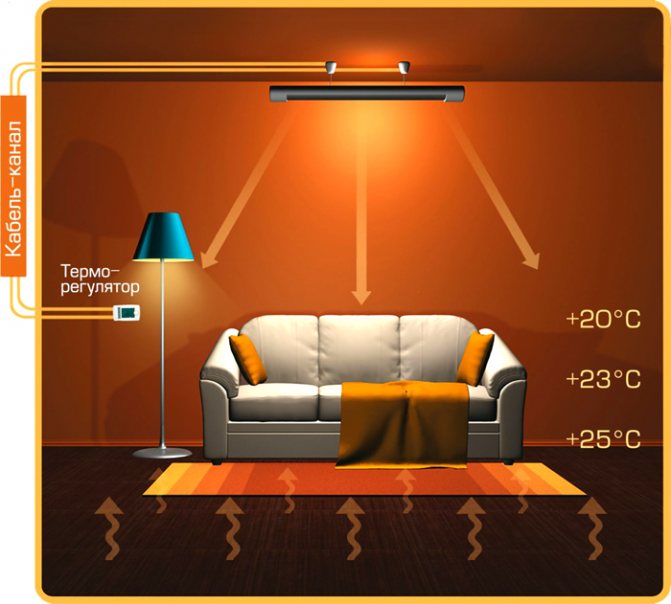
This is how the design works and distributes heat
Such devices also have a healing effect. They are used for some medical indications. When choosing a suitable product, pay attention to the characteristics of a particular room. It is important to clarify the number of windows, ceiling heights and the number of people living.
Disadvantages of carbon heaters
Before buying an infrared carbon heater, find out more information about the disadvantages of this equipment. The main disadvantage of the device is the fragility of the quartz tube. Because of this, the device may become unusable if dropped or subjected to a strong impact.

It is better not to drop such a device
Electricity consumption
To calculate how many kilowatts a heater consumes, you need to make simple calculations that any user can do. Does this or that heater consume a lot of electricity? Let's count.
Let's take a device with a power of 2 kW or two thousand watts as an example. For an hour of operation, it consumes two kilowatts. Let's imagine that on cold days the heater works eight hours a day, after an hour of operation there is a break for two hours. Sixteen kilowatts are consumed per day. The number was obtained by multiplying the number of working hours by the consumption per hour. The monetary equivalent is calculated simply: the price per kilowatt is multiplied by the number of kilowatts spent. Consumption amounts vary depending on the intensity of use of the device.
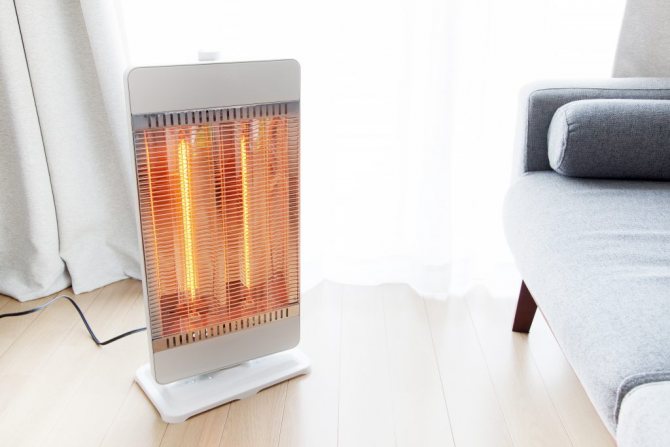
The data obtained helps to easily calculate how much electricity is spent per month throughout the cold season. The indicators depend on weather conditions, how often and for how long the heater operates. If we imagine that a particular month was very cold and the device heated the room every day for eight hours, the electricity consumption per month would be four hundred and eighty kilowatts.
To pay the minimum, you need to use climate control technology rationally. Buying a high-quality and suitable heater will allow you to organize minimal electricity consumption, which means it won’t hurt your wallet.
The use of any heating device will result in increased electricity consumption. To ensure that the increase in costs is insignificant, you need to find out in advance basic information about different types of heaters and choose a device with a high-quality thermostat. It is designed to set precise temperature conditions, regulate the operation of the device: turn it on and off, increase and decrease power.
The best option to optimize the process is to purchase a heater with a thermostat or thermostat. If necessary, the timer can be purchased separately.
Traditional heaters that are not equipped with temperature controllers are not the most convenient to use: they must be turned on and off independently depending on the air temperature. It also prevents the room from being preheated before family members arrive.
Devices without thermostats are characterized by increased energy consumption and there is a high risk of device overheating.
To eliminate a host of problems and potential dangers, you can purchase a thermostat for your heater.
It will help set the cycle, mode and power of the heating device. The use of thermostats allows you to optimize the heating process due to their functional features:
- You can independently set the desired temperature;
- devices automatically regulate the switching on and off of heating equipment;
- the heater turns on only when the temperature drops to the specified temperature, so it is possible to regulate electricity consumption and normalize the process of resource consumption;
- You can independently control the microclimate in the room, preventing the air from drying out.
Electronic, electromechanical thermostats and thermostats for infrared heaters are available for sale. GSM and WI-FI adjustable controllers have appeared.
Having equipped a thermostat, you begin to independently control the consumption of electrical energy - this is the main advantage of the device. Installing a thermostat has many advantages:
- function of automatically reducing the network load by fifty percent;
- full heating even with reduced network load;
- the ability to control every kilowatt of electricity;
- setting individual temperature conditions for any room;
- daily and weekly cycle programming;
- ease of operation;
- no clicks when changing operating mode.
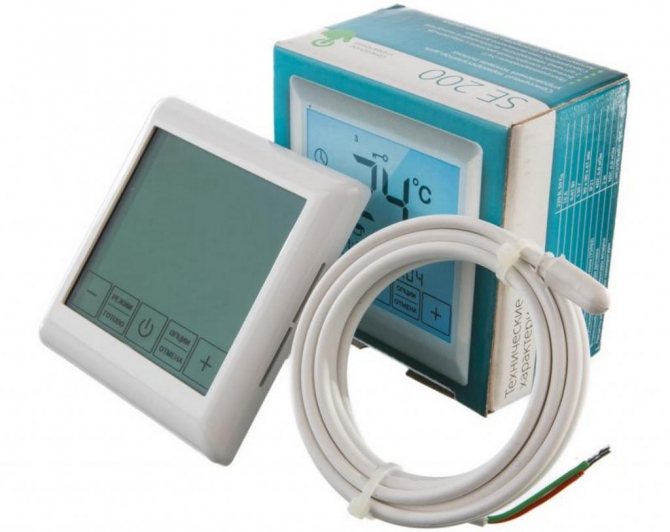
The thermostat can be installed at a distance from the heater, on its surface or inside the device.
Would you like your heater to have enough power to warm you up on the coldest winter evenings? Then you should approach your choice responsibly. Before purchasing, it is better to familiarize yourself with a number of parameters of devices of various types, take into account the footage of the room to be heated, as well as factors such as the absence/presence of thermal insulation, wall thickness and the maximum difference between street and room temperatures in the coldest time of the year. If there is an error in the calculations, you risk purchasing a heater with more power than necessary (which will result in overpayments for electricity), or, conversely, a device with less power that is not able to effectively warm the room area.
Operating principles of heaters
The note is important that if the meter in the house is designed for two tariffs, heating costs double. Let’s make a reservation: do not confuse the heating purposes of the room and auxiliary equipment. In the first case, convectors and infrared heaters are better suited; in the second, oil radiators and wind blowers are more often used.
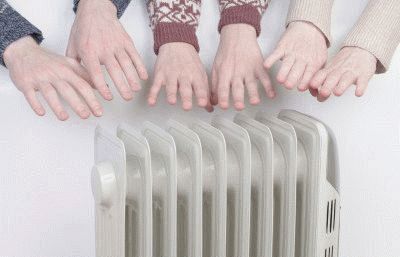
Any device is appropriate in a particular case. Then the power consumption of electric heaters is used for its intended purpose. Suppose you have a fireplace with coils heated red hot. The lion's share of heat is lost by radiation, while some is carried away by convection. What happens when using infrared heaters. There is a reflector that directs the flow of power in the right direction, heating only part of the room. The action of infrared devices is based on this phenomenon. The power consumption of an infrared heater will be less for equal heated areas. If necessary, we will provide the only sector of the room with heat. The rest of the room will warm up indirectly, the temperature there is lower. This is useful, for example, in spacious dining rooms, living rooms, and bedrooms.
This is interesting! Think of the Sun as an infrared heater. The luminary sends energy to the inhabited parts of the planet, and the poles languish in the cold. Household infrared heaters are like a celestial body.
What is the additional benefit of infrared heaters in terms of energy savings. The power is lower, therefore the costs are lower. Let's take into account the aspect of losses. Heat leaves through the walls, and the amount of energy outflow from the room to the street is proportional to the temperature difference (room and street) and inversely proportional to the wall resistance.
The higher the temperature along the fences, the greater the leakage. Consequently, spending increases. As the temperature of the walls decreases, the dew point passes deeper into the thickness. This naturally reduces the durability of the house; here are some reservations:
- The owner of the multi-apartment building is considered to be the operating organization (HOA, housing office, management company). It is logical to place the correct management of affairs on the shoulders of the organization. To make the house last longer, the facade is insulated and the walls are lined.
- As for private buildings, we will calculate the losses, compare them with the cost of insulation over the service life and choose a more profitable option.
An insulated house is cool in summer because the energy of the sun's rays does not penetrate inside. Calculate the modes using special programs, estimate whether air conditioning is needed if the walls are lined with insulation. Then calculate the cost of the material and the installation price from the final figure of the work. In the end, it will be more profitable to make high-quality insulation than to constantly pay more due to the vagaries of the weather.
There is no need to be afraid that the house will turn into a greenhouse - most insulation materials allow water molecules to pass through. To isolate materials from excess moisture, special membrane films are used.
How to calculate the heater power?
All modern appliances are equipped with thermostats that allow you to maintain a certain temperature. The type of heater itself has little effect on the efficiency of its operation - it is important to make the correct calculation.
To warm the air in an apartment, you need to use a convector to maintain the air temperature with a certain heat capacity. When calculating the heater power, the following indicators are taken into account:
- Minimum outdoor temperature in winter.
- Comfortable temperature in the room.
- Air density – 1.3 kg/m3.
- The heat capacity of air is 0.001 MJ.
- Heat 1 MJ – 0.277 kW/h
The amount of heat required to warm up a particular room can be calculated using the formula: c = Q/m(t2 - t1), where c is the specific heat capacity, Q is heat, m is air mass.
Let's transform the formula, we get: Q=c*m*(t2-t1), now we need to find out the mass of air in the room.
The formula for calculating it is simple: m= ϱ*P*h, where ϱ is the air density, P is the area of the room, h is the height.
Thus, the heat consumption formula takes on the formula: kWt= 0.277*c*ϱ*P*h*(t2-t1).
So, you can calculate the approximate energy costs for heating a small room (40 sq. m. with a ceiling height of 3 m. at a minimum temperature of 10 and the required temperature of +20).
kWt= 0.277*0.001*1.3*3*40*30= 1.29636 (kW/h).
Heat loss
There are several reasons why heat leaves a room:
- ventilation;
- thermal conductivity of walls, windows, ceilings, etc.;
- radiation.
According to SNiP standards, the approximate volume of fresh air circulation is 20 square meters. m per hour. To warm the newly received cool air, additional energy is needed. The calculation is made using the same formula: kWt= 0.277*0.001*1.3*20*30=0.21606 (kW/h).
The formula for calculating heat loss looks like this: Q=λ*(t1-t2)*S/L, where S is the wall area, L is the wall thickness, λ is the thermal conductivity coefficient, which is individual for each material.
For example, for brick λ = 0.5 W/(m*S), wall length = 8 m, height = 3 m, wall thickness = 0.5 m.
Q=0.5*30*96/0.5= 2880 (W)=2.88 (kW).
Thus, heat losses already exceed the necessary energy costs for heating the room without taking them into account. But do not forget that it is also necessary to take into account the indicator of the roof floor, and there heat losses can reach several tens. It turns out that to maintain a normal temperature in a room, almost fifteen times more electricity is required than for its “clean” heating.
Accounting for thermal insulation
Thermal insulation plays a significant role in calculating the required power. For example, a 2 m layer of mineral wool will significantly reduce heat loss, λ = 0.06 (for the above parameters):
Q= 0.06*30*40/0.2 = 360 (W) = 0.36 (kW).
When calculating floor heat loss, it is taken into account that the soil has an initial temperature of about 5 degrees Celsius.
If the room is insulated, then an average of 3 to 5 kW will be needed to compensate for heat loss. You can make your own calculation using the example given; data on specific materials can be easily found in reference books.

